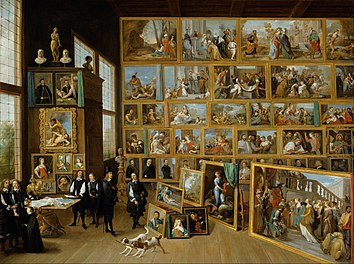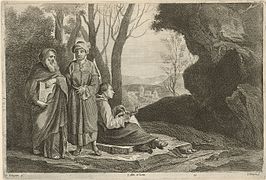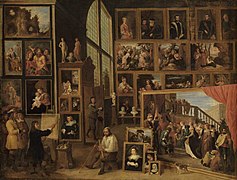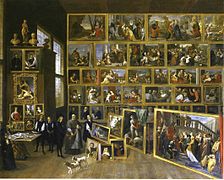| The Three Philosophers | |
|---|---|
 | |
| Artist | Giorgione |
| Year | c. 1505–1509 |
| Medium | Oil on canvas |
| Dimensions | 123 cm × 144 cm (48 in × 57 in) |
| Location | Kunsthistorisches Museum, Vienna |
The Three Philosophers is an oil painting on canvas attributed to the Italian High Renaissance artist Giorgione. It shows three philosophers – one young, one middle-aged, and one old.
The work may have been commissioned by the Venetian noble Taddeo Contarini, a Venetian merchant with an interest in the occult and alchemy. The Three Philosophers was finished one year before the painter died. One of Giorgione’s last paintings, it is now displayed at the Kunsthistorisches Museum in Vienna.
The painting was thought to have been finished by Sebastiano del Piombo, but a "new infrared reflectogram lends no support to the theory".
Description
The Three Philosophers was finished around 1509, and the current name of the work derives from a writing of Marcantonio Michiel (1484–1552), who saw it just some years after in a Venetian villa. The three figures portrayed are allegorical: an old bearded man, possibly a Greek philosopher; a Persian or Arab philosopher; and a sitting young man, enclosed within a natural landscape. In the background is a village with some mountains, the latter marked by a blue area whose meaning is unknown. The young man is observing a cave on the left of the scene, and apparently measuring it with some instruments. Since the end of the 19th century scholars and critics rejected on various grounds the earlier view that it is a representation of the three Magi gathered before Jesus' grotto.
Interpretations

Various interpretations about Giorgione's picture have been proposed. The Three Philosophers — the old man, the Arab figure, and the young man — could depict the transmission of knowledge, the Transmission of the Classics from the ancient Greeks philosophy through the Arab translations, that became actual again around the Italian Renaissance. The old man is representing a Greek philosopher, such as Plato or Aristotle, whose writings have been copied and transmitted through the Arab philosophers to the Italian Renaissance. The Arab philosopher is possibly representing the polyhistor Avicenna or Averroes, both Arab philosophers and Arab scientists from the Islamic Golden Age.
The young man could be seen as the new Renaissance science with roots in the past, looking into the empty darkness of the cave, symbolizing the yet undiscovered secrets. The cave might also symbolize the philosophic concept of Plato's Cave. "The emphasis on light and darkness in relation to philosophy has suggested one of the most credible interpretations of the painting, originally proposed by Meller, who argues that it represents the education of philosophers, as described in book 7 of Plato's Republic, whose famous allegory concerns the cave, the sun, and the dividing of the line".
New hypotheses about the figures, their identities and the symbolism are still currently advanced. In a note about the picture G. C. Williamsom, early in the 20th century, stated that "It represents Evander and his son Pallas showing to Aeneas the future site of Rome". The possibility that the three men are King Solomon, Hiram I, King of Tyre, and Hiram Abiff has been advanced by Neil K. MacLennan and Ross S. Kilpatrick.
It has been suggested that the figure of the young man can be inscribed neatly in a right-angled triangle for which the Pythagorean theorem applies. Karin Zeleny, relying on a reading of Polydore Vergil has proposed that the philosophers are the teachers of Pythagoras – Pherecydes of Syros and Thales. Thales has been painted as a Jew, while Pherecydes was mistakenly believed to be a Syrian. This interpretation was modified by Frank Keim who claimed that the older philosopher is in fact Aristarchus of Samos
Other scholars have asserted that the figures are typical representations for three stages of humanity (youth, middle and old age), three epochs of European civilization (Antiquity, Middle Age, Renaissance), the three Abrahamic religions or some combination of such general conceptions.
Augusto Gentili proposed that the picture illustrates the waiting for the Antichrist, based on conjunctionist astrology. On the sheet held by the oldest philosopher the word "eclipsis" and an astronomical diagram can be seen. The great conjunction of 1503 and the eclipse the same year were believed to be signs announcing its coming.
James Panero writes that, in interpreting The Three Philosophers, he is "partial to the poetic approach proposed by art historian Tom Nichols in his book Giorgione’s Ambiguity, in which he suggests that our interpretation is meant to remain free-floating and open-ended. Deliberate ambiguities, he writes, are Giorgione’s 'visual traps set to capture the viewer's curiosity and speculation.'"
Theatrum Pictorium
This painting was documented in David Teniers the Younger's catalog Theatrum Pictorium of the art collection of Archduke Leopold Wilhelm in 1659 and again in 1673, but the portrait had already gained attention from Teniers' portrayals of the Archduke's art collection: Tenier's copies that he made of the exhibits have long been recognised as a valuable historical resource.
-
 1673 engraving from Teniers' catalog, by Jan van Troyen
1673 engraving from Teniers' catalog, by Jan van Troyen
-

-
 1650
1650
-
 Gallery of Archduke Leopold Wilhelm in Brussels (Petworth), 1651
Gallery of Archduke Leopold Wilhelm in Brussels (Petworth), 1651
This painting is displayed at the Kunsthistorisches Museum in Vienna. While working on his picture, David Teniers the Younger made tiny separate copies of each and every picture as a study for the final big painting, depicting the duke's collection. It is a small copy that measures 21.5 x 30.9 cm.
References
| External media | |
|---|---|
 | |
| Audio | |
| Video | |
- Bellini and Giorgione in the House of Taddeo Contarini
- Panero, James, "Giorgione in the house", The New Criterion, February 2024, pp. 55-57.
- ^ David Alan Brown and Sylvia Ferion-Pagden, Bellini, Giorgione, Titian, and the Renaissance of Venetian Painting. National Gallery of Art and Kunsthistorisches Museum, p. 164 (2006 exhibition catalog).
- Tom Nichols, Giorgione's Ambiguity, London, UK: Reaktion Books, 2020, p. 140 (The Three Philosophers is the subject of pp. 135-142).
- Marcantonio Michiel, Notizie d’opere di disegno, manuscript, Venice (see Zeleny)
- ^ Beckett (1994), p. 167
- Settis S. (1990), Giorgione's Tempest: Interpreting the Hidden Subject, University Of Chicago Press
- ^ "Avicenna-and-Averroes -The Three Philosophers". lesmaterialistes.com. Retrieved 2 November 2014.
- "Writers following Wilde regarded Giorgione's figures as the Three Wise Men on the grounds that one of them may have been black. After Anderson argued in 1979 that x-raydiographic evidence cannot determine underlying color, the view that the Three Philosophers were Magi has not been repeated". David Alan Brown and Sylvia Ferion-Pagden, Bellini, Giorgione, Titian, and the Renaissance of Venetian Painting. National Gallery of Art and Kunsthistorisches Museum, p. 164 (2006 exhibition catalog).
- Beckett, Wendy (1994), The Story of Painting, The Essential Guide to the History of Western Art, Dorling Kidersley, ISBN 978-0751301335
- www.britannica.com
- "Avicenna". global.britannica.com. Retrieved 2 November 2014.
- G. C. Williamson, ed. (1903), The Anonimo. Notes on Pictures and Works of Art in Italy Made by an Anonymous Writer in the Sixteenth Century (trans. Paolo Mussi), London: George Bell and Sons, p. 102
- Neil K. MacLennan and Ross S. Kilpatrick, King Solomon & the Temple Builders: A Biblical Reading of Giorgione's Painting "The Three Philosophers". Heredom 9 (2001)
- Polydore Vergil, De inventoribus rerum, libri tres, Venetia, 1499
- Zeleny K., The Giorgione Code, Kunsthistorisches Museum Papers Archived 2013-12-02 at the Wayback Machine
- Keim F., Die Entdeckung der Jupitermonde 105 Jahre vor Galileo Galilei, 2009, Frankfurt am Main: Peter Lang Verlag.
- see Settis S., MacLennan and Kilpatrick, op. cit.
- Gentili, A., Giorgione, Giunti Editore (coll. Dossier d'art), 1999 (Google Books)
- Panero, James, "Giorgione in the house", The New Criterion, February 2024, pp. 55-57.
- 39 in Theatrum Pictorium, 1673
- "David Teniers and the Cabinet of Archduke Leopold William". courses.washington.edu. Retrieved 2 November 2014.
- "historians of Nederlandish art - David Teniers's Theatrum Pictorium". www.hnanews.org. Retrieved 2 November 2014.
- "venetian-art-in-late-17th - showing David Teniers the Younger's copy". renruskin.blogspot.se. Retrieved 2 November 2014.
- Gombrich E. "A note on Giorgione's 'Three Philosophers'". Burlington Magazine, 128 (1986), p. 488 . Only a copy made by David Teniers the Younger.
External links
- Page at Giorgione and Titian (in German)
- King Solomon and the Temple Builders
- Bellini and Giorgione in the House of Taddeo Contarini Exhibition of The Three Philosophers and Giovanni Bellini's St. Francis in the Desert at the Frick Collection, November 9, 2023 to February 4, 2024. Accompanying catalog: Bellini and Giorgione in the House of Taddeo Contarini
| Giorgione | |
|---|---|
| Paintings |
|
| Formerly attributed |
|